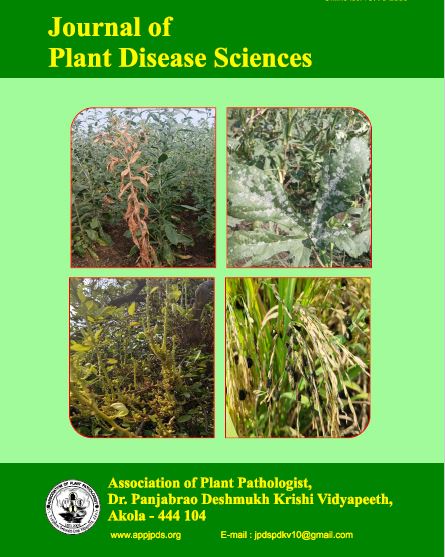IN VITRO ALTERNARIA ALTERNATA EVALUATION OF BOTANICALS AGAINST INDUCING LEAF BLIGHT IN GROUNDNUT
DOI:
https://doi.org/10.48165/Keywords:
Alternaria, alternata, Efficacy, Leaf blight, Groundnut, Plant extractsAbstract
Groundnut is a vital legume crop cultivated worldwide for its high oil and protein content, playing a significant role in food security and agro-industrial development, especially in India. However, its production is adversely affected by foliar diseases, particularly leaf blight caused by Alternaria alternata, which can lead to yield losses of up to 20%. This study aimed to evaluate the in vitro antifungal efficacy of seven botanicals — Allium sativum, Azadirachta indica, Zingiber officinale, Allium cepa, Curcuma longa, Datura stramonium, and Ocimum sanctum — against A. alternata using the poisoned food technique on potato dextrose agar (PDA). Aqueous extracts of the botanicals were tested at 15% and 20% concentrations. Results revealed significant suppression of mycelial growth by all botanicals compared to the control, with enhanced efficacy at the higher concentration. Zingiber officinale exhibited the strongest antifungal activity at both concentrations, achieving 92.21% inhibition at 20%, followed by Ocimum sanctum and Azadirachta indica. The study underscores the potential of plant-based extracts, particularly ginger, tulsi, and neem, as eco-friendly alternatives to chemical fungicides in managing leaf blight in groundnut. These findings contribute to sustainable disease management strategies aligned with environmental and food safety concerns.
References
Bhuyan, P. D., Tamuli, P. P., & Boruah, P. D. (2015). In vitro efficacy of certain essential oils and plant extracts against three major pathogens of Jatropha curcas L. FAO Plant Protection Bulletin, 33: 121–122.
Rakholia, D. J., Bhaliya, C. M., Rajani, V. V., & Patel, P. K. (2016). Efficacy of different plant extracts against Alternaria alternata causing ripe fruit rot of chilli (Capsicum annuum L.). Journal of Experimental Agriculture International, 14(3): 1–7.
Chaudhary, D. A., Nath, K. T., Bekariwala, B., & Mabhu, T. (2018). Management of Alternaria leaf blight of groundnut caused by Alternaria alternata. Indian Phytopathology, 71(4): 543–548.
Ramjegathesh, R., Ebenezer, E. G. M., & Muthusamy, M. (2011). Management of onion leaf blight by Alternaria alternata (Fr.) Keissler using botanical and bio-control agents. Plant Pathology Journal, 10: 192–196.
Hans, R., & Sharma, J. N. (2017). In vitro evaluation of botanicals, bio-agents and fungicides against Alternaria alternata causing mouldy core and core rot of apple. International Journal of Agriculture Sciences, 9(49): 4835–4840.
Thaware, D. S., Fugro, P. A., Jadhav, Y. T., Magar, S. V., & Karande, R. A. (2010). In vitro evaluation of different fungicides, plant extracts and bio-agents against Alternaria alternata (Fr.) Keissler causing leaf blight of cowpea. International Journal of Plant Protection, 3(2): 356–360.
Kantwa, S. L., Tetarwal, J. P., & Shekhawat, K. S. (2014). In vitro effect of fungicides and phytoextracts against Alternaria alternata causing leaf blight of groundnut. Agriculture and Veterinary Science, 7(6): 28–31.
Vincent, J. M. (1947). Distortion of fungal hyphae in the presence of certain inhibitors. Nature, 159: 850. https://doi.org/10.1038/159850a0
Madhusudhana, B. (2013). A survey on area, production and productivity of groundnut crop in India. Journal of Economics and Finance, 1: 1–7.

